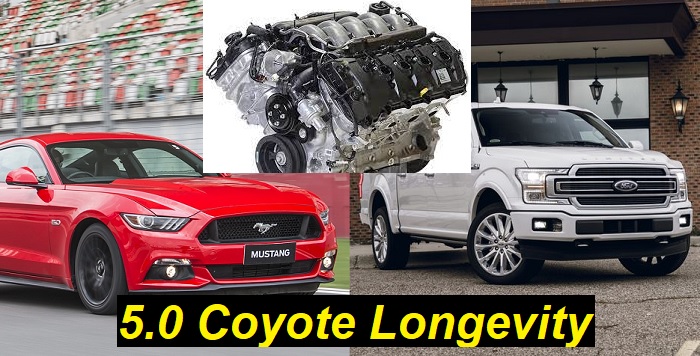Classic Ford engines are now a part of the automobile history. They are still used in many old trucks and SUVs, they are often used for tuning in project cars. Those big and mighty engines were much better and more reliable than modern turbocharged units with twice smaller displacement and higher power.
Ford's 5-liter Coyote engine is not old and it's still not a classic option. But it's one of the last incarnations of the modular engines by Ford which is a classic lineup you will love having. The Coyote engines are known for their astonishing power, wonderful longevity, and great reliability. Ford has already used them in a lot of standard and sports vehicles.

Key features and my opinion about the engine
- Production years:2011-now
- Average lifespan of Coyote:280,000-310,000 miles
- Fuel supply type:port injection, later-combined injection (port+direct)
- Power range:360-460 hp
- Fuel efficiency:awful
- Engine block material:aluminum
- Engine reliability score:high
- The most common problems:oil leaks, weak plugs and coils, electronic throttle issues, EGR problems.
What is actually the 5.0L Coyote engine by Ford?
This engine was based on the 4.6 and 5.4 modular engines by Ford and it embraces all the main technical evolution features the Ford Company has to offer. This is a V8 engine with classic construction and basically all well-checked and well-known technologies inside. Someone will say that this is one of the best Ford engines in history, but let's learn more about it.
Initially, the engine was designed to compete with a Camaro engine (6.2 LS3 by Chevy) and it was meant to power the Mustang GT V8. But then Ford has found some more applications for this engine.
Mainly, the 5.0 Coyote has been used in such vehicles:
- Mustang GT (the one with the V8 engine).
- Ford F-150 truck in higher trims.
- Ford Falcon GT (it was supercharged for this car).
- TVR and Panoz sports cars.
Some of these engines were supercharged, but most Coyotes come without a supercharger, they are naturally aspirated engines with big displacement.
We will not make you waste a lot of your time on technical specs, but some facts we still want to say:
- The engine has different versions with power from 360 to 460 horsepower.
- The torque range is 380-487 pound-feet which is a lot for a gasoline engine.
- Three transmission types are available: 6-speed manual, 6-speed automatic, 10-speed automatic.
- In later versions, the compression was taken from 10.5 to 12.0 increasing the power and torque (but reducing the longevity).
- The engine offers the same power range as its competitors by Chevy and Dodge, but it has smaller displacement which is a big advantage if you think about that.
- The gas mileage is not that bad - the Mustang GT can show 20 MPG combined and around 17 MPG in the city traffic.
As you see, the engine is good. It doesn't offer anything brilliant, but we can say it's better than many competitors. The main advantages are its displacement, fuel consumption, and power to torque ratio.
Now, we should pay more attention to reliability and longevity. Here, we also should say that Mustang buyers don't always seek reliability. They want performance and they want to have fun when driving. While F-150 buyers will prefer longevity and reliability because they buy their cars for long service. So, how have the Ford engineers connected these two completely different factors in one engine?
Ford 5.0 Coyote reliability - anything interesting?
We know that Mustang fans think that the Coyote engine is one of the best options available on the market right now. This engine is extremely reliable. Some Mustang GTs have been reported to go over 150 000 miles with no issues at all. We presume the longevity of this engine is good enough to let you drive it for at least 200 000 miles in a Mustang and at least 250 000 miles in an F-150.
The difference in longevity is obvious. The Mustang versions of the 5.0 Coyote engine were equipped and tuned differently from the F-150 versions. This is the secret of how Ford managed to equip so different vehicles with the same engine. The Mustang Coyotes are more sporty, they offer more power, so they aren't as durable. The F-150 Coyotes are more about durability, not speed and power.
Here are some things you should know about this engine's durability:
- the Coyotes started in 2011 and they are relatively new and fresh engines, a lot of Ford classic problems had been solved before this engine was engineered;
- different versions of Coyote engines were tuned according to which types of cars they were going to power;
- the engine blocks are immortal, they can be repaired even after working with no oil and getting many damages;
- DOHC heads are so simple and reliable that we can't think of what can break or malfunction here;
- the fuel injection is extremely simple and reliable - this is the most common problem of all modern engines with this displacement;
- basically, no major recalls have been registered within the last 11 years, so the engines are thought to be really good.
Also, you can check the average mileage of the 2011 Mustangs and F-150 trucks that are now offered for sale in the USA. A lot of them will have a mileage of over 200 000 miles. If you talk to the people who sell these cars, they will tell you that the engine hasn't caused any problems.
Of course, the longevity of your 5.0L Coyote engine depends much on how you use it and how you maintain the unit. But we are now talking about the average situation. We are sure that with superb maintenance and careful driving, this engine can go up to 400 000 miles or something without causing big problems and with minor repairs only.
By the way, we've also written an article about the engine tick problem in Coyote - you may want to have a look!
What do experts say about the Ford Coyote engine?
We've spoken to some experienced car mechanics that deal with Ford engines and they helped us clear out some points. First of all, they said that the second generation of the Coyote engine (2015-2018) and the third generation (2018-now) are not as good as the first one. In 2011, Ford offered a revolutionary engine that was really cool in all aspects. But with newer technologies, this engine started malfunctioning more.
It's still a good unit, but it loses in comparison with the first-gen engine. Also, the 5.0L Coyote by Ford is said to depend much on the quality of oil and regularity of maintenance. If you don't change the oil in this engine for years, it will show you all the bad sides of Ford technologies. All the major problems and breakdowns are personal and depend on the way you drive your vehicle.
So, we can say that experts recommend the 5.0 Coyote engine.
Popular problems and breakdowns that can happen
Your Coyote engine will be much more durable if you listen to engineers and experts and complete the maintenance more often than needed. Especially, after 100 000 miles. The 5-liter Ford engine will probably start burning some oil and you will have to check the level of oil regularly.
The so-called oil starvation is one of the main reasons why Mustangs and F-150 trucks end up spending weeks in the car repair shops. The quality of the oil is another important factor. Better use Ford original oil. It's expensive, but it suits best the Coyote engine.
Here are some problems you may want to know about:
- Oil leaks. You may think it's not a big problem. But in your Coyote engine, the oil can leak right on some wiring or connections. This may cause big problems in the end.
- Spark plugs and ignition coil failures. This may cause big problems eventually because unburned fuel will burn in the catalytic converter reducing its lifespan. Also, fuel explosions in cylinders will damage the cylinder walls.
- EGR valve problems. This is a big problem for people who own vehicles with modern engines. This equipment for gas recirculation keeps delivering problems.
- Electronic throttle failure. Once you may press the gas pedal and see no reaction. Or your car may accelerate unintentionally which is a very dangerous symptom because it can lead to an accident.
As you see, the 5-liter Coyote engines by Ford still have some problems. But if they are maintained and serviced well, you will not see these problems. Most of them will only bother you when the mileage of the engine is insanely high.
Final words
Now you know everything about the magnificent Coyote engine. The 5.0L Ford engine for a Mustang and an F-150 is not a bad unit at all. This is a very reliable and durable engine that can last up to 250 000 miles and more depending on the quality of regular maintenance. This is one of the best options you can choose in a modern Mustang generation. And this engine can compete with the turbocharged engines for F-150 trucks.
About the authors
The CarAraC research team is composed of seasoned auto mechanics and automotive industry professionals, including individuals with advanced degrees and certifications in their field. Our team members boast prestigious credentials, reflecting their extensive knowledge and skills. These qualifications include: IMI: Institute of the Motor Industry, ASE-Certified Master Automobile Technicians; Coventry University, Graduate of MA in Automotive Journalism; Politecnico di Torino, Italy, MS Automotive Engineering; Ss. Cyril and Methodius University in Skopje, Mechanical University in Skopje; TOC Automotive College; DHA Suffa University, Department of Mechanical Engineering






Add comment